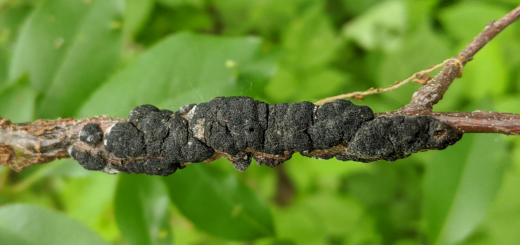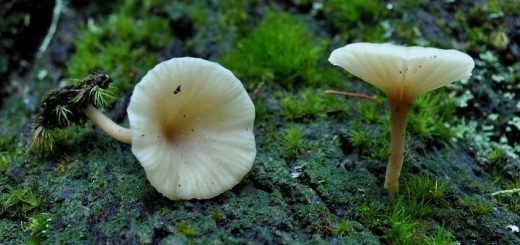#148: Cladonia cristatella, British Soldier Lichen
The lichen Cladonia cristatella is easy to identify thanks to the bulging, bright red cap that is supported by a thin, pale green stalk. The lichen earned its common name “British Soldier Lichen” because its bright red color seemed reminiscent of the uniforms worn by the British during the American Revolutionary War. cristatella is a common lichen of northeastern North America, but it can be found in many places east of the Great Plains. This lichen is not very well anchored to its substrate, so it prefers to grow in places that are protected from the elements. Look for it on the forest floor, dead wood, the bases of trees, and mossy areas. I have found it growing on rocks, but only in crevices where it is protected from the wind.
All lichens are composite organisms composed of a fungus and at least one alga. In the British Soldier Lichen, the fungus is Cladonia cristatella and the alga is Trebouxia erici. C. cristatella belongs to the phylum Ascomycota, class Ascomycetes, order Lecanorales (which contains mostly lichenized fungi), and family Cladoniaceae. T. erici is a green alga in the kingdom Plantae, phylum Chlorophyta, class Trebouxiophyceae, and order Microthamniales. The fungus is the dominant partner in the lichen relationship, so the entire lichen gets the same name as the fungus. Fungi and algae in a lichen have a complicated relationship. It seems most likely that this relationship is a controlled parasitism, where the fungus consumes about as many algal cells as are produced. This situation can be thought of as the fungus farming the algae. Of course, the algae do benefit from this arrangement: they are protected from the environment, they are provided with nutrients, and they are able to grow in locations they normally could not.
C. cristatella is fairly easy to spot because the bright red cap makes it stand out against the green, brown, and grey colors of other lichens, mosses, tree bark, or rocks. Once you spot one of these red caps, look below it to find the main body of the lichen. British Soldier Lichen is a fruticose lichen, meaning it is composed of cylindrical, branch-like structures. C. cristatella generally grows upward from its substrate, which may be the ground, rocks, or trees. It frequently forks, making it look somewhat like a tiny tree. Each ‘branch’ of the British Soldier Lichen is pale green in color and smooth to finely bumpy. The green color comes from the algal partner and is brighter when the lichen has enough water to actively photosynthesize. Many of the lichen’s branches are capped with smooth, irregular bulges. To me, these caps have about the same texture and shape as Nerds candy.
As a fruticose lichen, the branches of C. cristatella are composed of three layers of cells. From the outside in, these are: the cortex, photobiont, and medulla. The cortex is a dense layer of fungal cells that helps protect the inner layers from the external environment. Just underneath the cortex, the photobiont layer contains the algal cells. Each alga is held in place by a net of fungal cells. Some of the fungal cells penetrate the algae to more efficiently exchange nutreints and sugars. The medulla forms the center of the branch and serves to support the rest of the lichen.
The caps of the British Soldier Lichen are actually fungal reproductive structures called apothecia. Each apothecium is lined by a layer of asci, which are specialized cells that produce and release sexual spores. The bright red color serves to block some sunlight and protect the developing spores from damage. Nobody is quite sure what purpose sexual spores serve in lichen reproduction. These spores can carry fungal DNA to new locations, but they do not bring the algal partner along. Consequently, the spore must land right next to a free-living cell of its photobiont in order to successfully form a new lichen. The chances of this happening are very slim. However, C. cristatella is almost always found with an apothecium atop every one of its branches. This indicates that the fungus is devoting a surprising amount of energy to sexual reproduction. If this process was useless, evolution would have gotten rid of it a long time ago. So presumably, C. cristatella successfully reproduces sexually more often than we realize.
Since sexual reproduction is so chancy, lichens usually reproduce using asexual methods. As far as I know, C. cristatella does not form structures specialized for this purpose. However, it can still spread asexually by physically breaking apart (due to animal activity, falling things, strong wind, etc.) and being carried (by animals, wind, water, etc.) to a new location.
Apparently there is a market for British Soldier Lichen. It is primarily used as a colorful addition to things like terrariums. As far as I know, humans do not use this like for any other purposes.
See Further:
http://botit.botany.wisc.edu/toms_fungi/jul2002.html
http://www.fcps.edu/islandcreekes/ecology/british_soldiers.htm
http://www.sierrapotomac.org/W_Needham/BritishSoldierLichen_070430.htm
http://lichenportal.org/portal/taxa/index.php?taxon=53394 (pictures only)
http://plants.usda.gov/core/profile?symbol=clcr2









![#011: Characteristics of Kingdom Fungi [Archived]](https://www.fungusfactfriday.com/wp-content/themes/hueman/assets/front/img/thumb-small-empty.png)


1 Response
[…] British soldier lichen (Cladonia cristatella) is a friendly pop of red along the trail. Lichen are a combination of fungus + either algae or cyanobacteria (or both); in the case of this particular lichen, it’s a green alga (Trebouxia erici) that supplies nourishment through photosynthesis while the fungus (or mycobiont) is Cladonia cristatella, a member of the Ascomycota phyllum. Lichen is named for the dominant partner in the semi-symbiotic or controlled parasitic relationship, which is the fungus, which “farms” the algae for food, while providing the algae with substrate and protection. (More on these lichen at Fungus Fact Friday.) […]